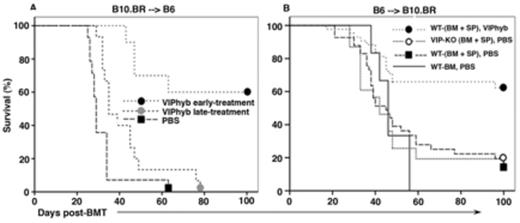Abstract
Background: Separating graft versus leukemia (GvL) from graft versus host disease (GvHD) is a critical issue in allogeneic bone marrow transplantation (allo BMT) for malignant hematopoietic cancers. Vasoactive intestinal peptide (VIP) is capable of inducing tolerogenic dendritic cells (DC) from bone marrow progenitors that limit GvHD (Blood 2006 107:3787). We have published that use of donor mice deficient in VIP or pharmacological blockade of VIP-signaling both increased cellular anti-viral activity in murine allo BMT models of CMV infection (JI 2011 187:1057, Blood 2013 121:2347). We hypothesized that blockade of VIP could enhance GvL activity without increasing GvHD in recipients of allo BMT.
Methods: We used the B10BR to B6 and B6 to B10BR murine allo BMT models, with luciferase-expressing C1498 acute myeloid leukemia and LBRM acute T-lymphoblastic lymphoma tumor cells, respectively, to study the effect of VIP-signaling on GvL and GvHD. Murine recipients of WT TCD-BM plus splenic allografts (5 x106 TCD-BM plus 0, 0.5, 1.0 and 3.0 x106 splenocytes) were treated with 7 daily s.c. injections of VIPhyb, a VIP antagonist, on d-1 to d+5 (early treatment) or d+6 to d+12 (late treatment), or PBS. Tumor cells were administered by i.v. injection one day before transplant (d-1), and tumor burden was monitored by bioluminescence imaging (BLI). Expression of activation immune cell markers, intracellular cytokines, and ex vivo cytolytic activity against tumor were measured by flow cytometry. TCR-β clono-types were analyzed by TCR-β CDR3 deep sequencing.
Results: Recipients of VIP-KO donor cells and VIPhyb-treated recipients of WT donor cells did not have more GvHD than untreated recipients of equivalent numbers of splenocytes from WT donors. VIPhyb-treatment significantly increased survival of transplant tumor recipients in the B10.BR to B6 model with C1498 (2 replicate experiments, n= 10 in VIPhyb early-treatment, p<0.001; n=15 in VIPhyb late-treatment, p=0.005 vs. control, n=14; Figure 1A) and in the B6 to B10.BR model with LBRM (3 replicate experiments in 0.5 x 106 splenocyte dose, n=10, p =0.001 in VIP-KO, n=20, p=0.01 in VIPhyb-treatment, n=40 in control; Figure 1B). All recipients of TCD-BM alone died of tumors within 60 days post-BMT. VIPhyb-treatment, and transplantation of VIP-KO donor cells, led to significant decreases in tumor-burden as measured by BLI. Tumor-free recipients following VIPhyb treatment re-challenged with a 10x dose of LBRM had 100% survival compared with 40% survival among saline-treated recipients (p=0.009). Secondary transplantation of splenocytes from tumor-free VIPhyb-treated recipients resulted in 100% tumor-free survival compared with 30% survival among recipients of naive donor T cells (p=0.001). Splenic T cells, and cDC and pDC from VIPhyb-treated mice expressed lower levels of PD-1, and PD-L1, respectively, compared with saline-treated control (Figure 2). Donor T cells from leukemia-bearing mice treated with VIPhyb expressed higher-levels of ICOS and IFN-γ compared with T cells from saline-treated mice. Both cDC and pDC from VIPhyb-treated mice had increased expression of ICOS-L and MHC-II. Donor T-cells recovered from mice treated with VIPhyb had increased levels of granzyme B and enhanced cytolytic activity against tumor targets but not against non-tumor recipient-type splenocytes or third party splenocytes. Genetic or ex vivo depletion of donor NK cells or CD8+ T-cells abrogated the enhanced GvL activity seen with VIP antagonist-treatment. VIPhyb had no direct anti-proliferative activity against LBRM in vitro using a range of concentrations that exceeded predicted in vivo concentration. VIPhyb-treated transplant recipients had expansion of oligo-clonal T-cell subsets that conferred leukemia protection to secondary recipients and expressed distinct TCR-β sequences compared with T cells from donor or GvHD mice.
Conclusions: Blocking VIP signaling enhanced GvL activity without increasing GvHD. Donor CD8+ T-cells and NK cells were indispensable for the enhanced GvL activity. The ability of VIP antagonist treatment to down-regulate PD-1/PD-L1 signaling and enhance adaptive cellular immunity is a novel approach to treat and prevent relapse in allo BMT.
VIPhyb-treatment enhanced the GvL activity (5 x 106 TCD BM and 0.5 x 106 splenocytes from WT or VIP-KO donors)
VIPhyb-treatment enhanced the GvL activity (5 x 106 TCD BM and 0.5 x 106 splenocytes from WT or VIP-KO donors)
VIPhyb-treatment reduced expression of PD-1 on T cells and PD-L1 on DC
No relevant conflicts of interest to declare.
Author notes
Asterisk with author names denotes non-ASH members.



This feature is available to Subscribers Only
Sign In or Create an Account Close Modal